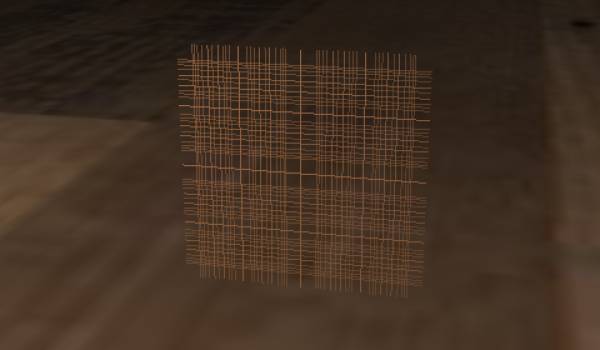Primitives
Due to performance optimization Gorilla3D introduces their own primitive models. Default FireMonkey primitives TCube, TSphere, TPlane and TCylinder are still supported, but they reduce render speed a lot when there is used large subdivisioning by the user.
A sphere could reach an enormous amount of vertices, when subdivision is set to high values. Each time the sphere gets rendered, all those vertices are transfered to GPU.
To solve this problem, the Gorilla3D primitives TGorillaCube, TGorillaSphere, TGorillaCylinder and TGorillaPlane are inherited from TGorillaMesh and are able to use static framebuffers for fast rendering.
Static framebuffers will only push vertex data once to the GPU and render the elements only by switching to the framebuffer.
Supported primitives
TGorillaCube

uses Gorilla.Cube; [...] begin FCube := TGorillaCube.Create(GorillaViewport1); FCube.Parent := GorillaViewport1; /// increase the number vertices, but in many cases subdivisions of 1 are enough for a cube. {$IFDEF MSWINDOWS} /// only on window platform a large number of vertices. FCube.SubdivisionsDepth := 128; FCube.SubdivisionsHeight := 128; FCube.SubdivisionsWidth := 128; {$ELSE} // Android platform is limited to 32K vertices for meshes. FCube.SubdivisionsDepth := 32; FCube.SubdivisionsHeight := 32; FCube.SubdivisionsWidth := 32; {$ENDIF} /// make it larger FCube.SetSize(2, 2, 2); /// to forbid mouse interaction use: FCube.SetHitTestValue(false); end;
TGorillaSphere

uses Gorilla.Sphere; [...] begin FSphere := TGorillaSphere.Create(GorillaViewport1); FSphere.Parent := GorillaViewport1; /// create a sphere with more detail {$IFDEF MSWINDOWS} /// create a very detailled sphere. FSphere.SubdivisionsAxes := 128; FSphere.SubdivisionsHeight := 128; {$ELSE} /// on Android platform number of vertices is limited to 32K. FSphere.SubdivisionsAxes := 32; FSphere.SubdivisionsHeight := 32; {$ENDIF} /// make it larger FSphere.SetSize(2, 2, 2); /// to forbid mouse interaction FSphere.SetHitTestValue(false); end;
TGorillaCylinder

uses Gorilla.Cylinder; [...] begin FCylinder:= TGorillaCylinder.Create(GorillaViewport1); FCylinder.Parent := GorillaViewport1; {$IFDEF MSWINDOWS} /// create a very detailled cylinder. FCylinder.SubdivisionsAxes := 128; FCylinder.SubdivisionsCap := 32; FCylinder.SubdivisionsHeight := 32; {$ELSE} /// on Android platform number of vertices is limited to 32K. FCylinder.SubdivisionsAxes := 32; FCylinder.SubdivisionsCap := 1; FCylinder.SubdivisionsHeight := 1; {$ENDIF} /// make it larger FCylinder.SetSize(2, 2, 2); /// to forbid mouse interaction FCylinder.SetHitTestValue(false); end;
TGorillaCapsule

uses Gorilla.Capsule; [...] begin FCapsule:= TGorillaCapsule.Create(GorillaViewport1); FCapsule.Parent := GorillaViewport1; FCapsule.Radius := 0.35; {$IFDEF MSWINDOWS} /// create a very detailled capsule. FCapsule.Segments := 128; FCapsule.Rings := 64; {$ELSE} /// on Android platform number of vertices is limited to 32K. FCapsule.Segments := 32; FCapsule.Rings := 8; {$ENDIF} /// make it larger FCapsule.SetSize(2.75, 2, 2.75); /// to forbid mouse interaction FCapsule.SetHitTestValue(false); end;
TGorillaPlane

uses Gorilla.Plane; [...] begin FPlane:= TGorillaPlane.Create(GorillaViewport1); FPlane.Parent := GorillaViewport1; /// placing it as floor FPlane.RotationAngle.X := -90; {$IFDEF MSWINDOWS} /// create a very detailled plane. FPlane.SubdivisionsHeight := 128; FPlane.SubdivisionsWidth := 128; {$ELSE} /// on Android platform number of vertices is limited to 32K. FPlane.SubdivisionsHeight := 16; FPlane.SubdivisionsWidth := 16; {$ENDIF} /// make it larger FPlane.SetSize(10, 5, 0.1); /// to forbid mouse interaction FPlane.SetHitTestValue(false); end;
TGorillaCone

uses Gorilla.Cone; [...] begin FCone := TGorillaCone.Create(GorillaViewport1); FCone.Parent := GorillaViewport1; FCone.TopRadius := 0.01; FCone.BottomRadius := 2; {$IFDEF MSWINDOWS} /// create a very detailled cone. FCone.Sides := 128; FCone.HeightSegments := 128; {$ELSE} /// on Android platform number of vertices is limited to 32K. FCone.Sides := 32; FCone.HeightSegments := 1; {$ENDIF} /// make it larger FCone.SetSize(2, 2, 2); /// to forbid mouse interaction FCone.SetHitTestValue(false); end;
TGorillaTube

uses Gorilla.Tube; [...] begin FTube := TGorillaTube.Create(GorillaViewport1); FTube.Parent := GorillaViewport1; FTube.TopRadius1 := 0.25; FTube.TopRadius2 := 0.15; FTube.BottomRadius1 := 0.5; FTube.BottomRadius2 := 0.15; {$IFDEF MSWINDOWS} /// create a very detailled tube. FTube.Sides := 128; {$ELSE} /// on Android platform number of vertices is limited to 32K. FTube.Sides := 24; {$ENDIF} /// make it larger FTube.SetSize(2, 2, 2); /// to forbid mouse interaction FTube.SetHitTestValue(false); end;
TGorillaTorus

uses Gorilla.Torus; [...] begin FTorus := TGorillaTorus.Create(GorillaViewport1); FTorus.Parent := GorillaViewport1; FTorus.Radius1 := 1; FTorus.Radius2 := 0.3; {$IFDEF MSWINDOWS} /// create a very detailled torus. FTorus.RadSegments := 128; FTorus.Sides := 128; {$ELSE} /// on Android platform number of vertices is limited to 32K. FTorus.RadSegments := 24; FTorus.Sides := 18; {$ENDIF} /// make it larger FTorus.SetSize(2, 2, 2); /// to forbid mouse interaction FTorus.SetHitTestValue(false); end;
TGorillaGrid

uses Gorilla.Grid; [...] begin FGrid := TGorillaGrid.Create(GorillaViewport1); FGrid.Parent := GorillaViewport1; /// make it larger FGrid.SetSize(10, 10, 10); /// pre configure grid, othwise nothing will be rendered FGrid.DefaultLines := 16; FGrid.Frequency := 0.25; FGrid.Marks := 0.5; FGrid.LineColor := TAlphaColorRec.Cornflowerblue; end;
TGorillaGrid3D
The Grid3D component is a container holding 3 instances of TGorillaGrid for each 3D axis: GridX, GridY and GridZ.

uses Gorilla.Grid; [...] begin FGrid3D := TGorillaGrid3D.Create(GorillaViewport1); FGrid3D.Parent := GorillaViewport1; /// make it larger FGrid3D.SetSize(10, 10, 10); /// to modify each grid inside of the container use GridX, GridY or GridZ property FGrid3D.GridX.DefaultLines := 16; FGrid3D.GridX.Frequency := 1.5; FGrid3D.GridX.Marks := 2.5; FGrid3D.GridX.LineColor := TAlphaColorRec.Cornflowerblue; end;
